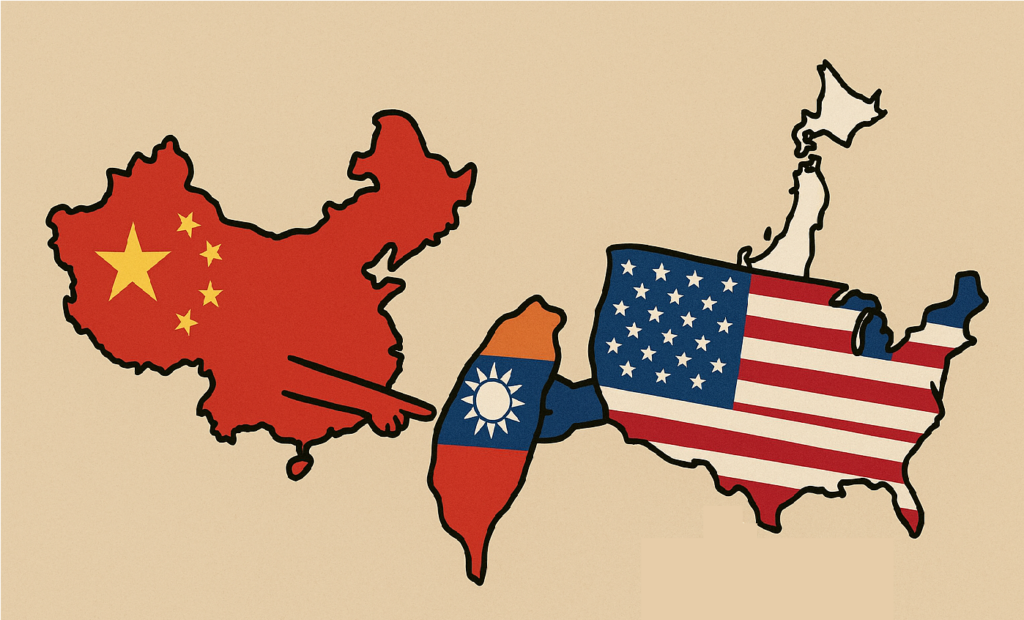
- Beijing has increased the deployment of fighter jets and naval vessels around Taiwan in recent years to press its claim of sovereignty, which Taipei rejects.
- Today, Taiwan operates as an independent and sovereign country, which is a red sign for Beijing.
- The Taiwan Strait is most likely viewed as the flashpoint for a potential World War III, especially after Taiwan’s strongest ally, the United States, re-elected Donald Trump as President.
A Historical Rift
The dispute between China and Taiwan dates back to the period when, after WW 2, Taiwan was given by Japan to the Republic of China, led by Kuomintang’s Chiang Kai-shek. The nationalist government forces fled to Taiwan after losing the Chinese civil war to Mao’s communist fighters. The People’s Republic of China was established on the mainland, while the Republic of China continued to rule Taiwan, claiming legitimacy. Gradually, with time, Taiwan transitioned into a democracy, while during the Cold War, in 1971, the United Nations transferred China’s UN seat from them to the People’s Republic of China. Today, Taiwan operates as an independent and sovereign country, which is a red sign for Beijing. Only 11 countries and the Vatican recognise Taiwan’s claim to statehood, despite its maintaining significant global relations and considerable military, cultural, and economic ties across the globe, despite the diplomatic constraints imposed by China.
Tokyo’s New Voice
Currently in the news, Japan’s newly elected Prime Minister Sanae Takaichi sparked a diplomatic spat with China over her remarks that a hypothetical Chinese attack on democratically ruled Taiwan could trigger a military response from Tokyo. China lodged a formal protest against it, considering China an internal affair. China’s Consul General in the Japanese city of Osaka shared a news article about Takaichi’s remarks on Saturday and commented, “the dirty head that sticks itself in must be cut off”. Tokyo said the comments made on the social media site X were “extremely inappropriate”. The diplomat’s comments were later deleted. Japan’s leaders usually avoid mentioning Taiwan in public mentions, even after it is favoured by Tokyo’s main security ally, the USA.
Beijing’s Muscle Flex
Beijing has increased the deployment of fighter jets and naval vessels around Taiwan in recent years to press its claim of sovereignty, which Taipei rejects. In April 2025, China sent its army, navy, air, and rocket forces to surround Taiwan for large-scale drills that Beijing said were aimed at practising for “precision strikes” and a blockade of the island. In Washington, President Donald Trump “is emphasising the importance of maintaining peace in the Taiwan Strait,” White House Press Secretary Karoline Leavitt told a briefing. She reiterated US “opposition to any unilateral attempts to change the status quo by force or coercion.”
Washington’s Balancing Act
While the United States is legally bound to provide arms to Taiwan, Washington has long maintained “strategic ambiguity” regarding whether it would deploy its military to defend the island from a Chinese attack.
The United States’ recent meeting with China over tariff issues and rare earth materials is seen as a move of cooperation rather than confrontation. The US also understands that the position of China has changed under Xi Jinping, as expanded its military, economic, and diplomatic ties all over and cannot be ignored or sidelined. The US is now dealing with China more an equal stage, which is what Trump referred to as ‘G-2’. Before the US demonstrated its military base, port project, oil and refuelling support, it showed its Strategic presence and containment policy towards China. The Quad grouping and US allies were prepared to support Taiwan, but as of now, the situation has changed significantly.
India’s Cautious Diplomacy: Standing Firm Yet Neutral
In August, when the Chinese Foreign Minister visited India, the two sides had elaborate discussions on the border issue, marking a positive momentum in bilateral ties. However, even though the talks concluded on a positive note, a brief public spat between China and India on the ‘Taiwan’ issue became the unexpected highlight of the meeting. A Chinese Foreign Ministry readout claimed that External Affairs Minister S. Jaishankar had, in his meeting with Chinese Foreign Minister Wang Yi, said that ”Taiwan belonged to China”.
The Indian government then stressed that it has not changed its policy on Taiwan. To promote economic, scientific and technological, and cultural cooperation with Taiwan is India’s position with Taiwan, and it remains the same and not changed, and will continue to remain the same.
The Taiwan Strait
The Taiwan Strait is most likely viewed as the flashpoint for a potential World War III, especially after Taiwan’s strongest ally, the United States, re-elected Donald Trump as President. With his “Make America Great Again” and protectionist policies, and his loud claims of the U.S.–China relationship as a “G-2,” Taiwan faces a heightened threat from a great, powerful, nuclear-armed neighbour with one of the world’s largest military forces and an ambition to control the island. In this situation, Taiwan has begun taking its self-defence more seriously, recognising that President Trump is unlikely to help a country that is not strong enough to defend itself.
It is yet to be seen how, in the changing scenarios and shifting alliances and relations, countries will continue to follow their stand on Taiwan.
REFERENCES
- https://www.reuters.com/world/china/logistics-war-how-washington-is-preparing-chinese-invasion-taiwan-2024-01-31/
- https://www.reuters.com/world/china/why-did-japan-pms-taiwan-remarks-cause-such-stir-2025-11-11/
- https://www.bbc.com/audio/play/w3ct7178
- https://www.thejakartapost.com/world/2025/04/02/china-holds-large-scale-military-drills-around-taiwan.html
- https://www.orfonline.org/expert-speak/china-watches-india-taiwan-ties-with-unease
Garima Sharma is a Master’s student in International Relations at Jawaharlal Nehru University. Her interests include public policy, international governance, geopolitics, defence, and security. Views expressed are the author’s own.
